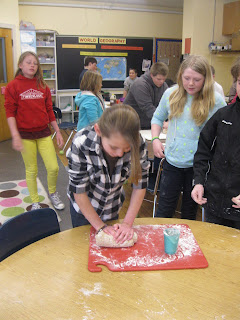a) wasn't ripe yet
b) required more preparation than slicing
c) I had no idea what to do with
d) all of the above
So although it hadn't been in my plans to cook this week, I threw a dart at my plan book and came up with Wednesday morning. I figured I'd do some research over the weekend and hold a summit with Emilyinthekitchen on Monday in order to be ready for Wednesday.
Then medical chaos temporarily struck my family (everyone's fine now, thank you) and I had almost no time/energy for weekend planning Nor was I in school on Monday. Tuesday morning, I asked Emilyinthekitchen what I should do with my random set of ingredients. "Bring it all down to the kitchen so I can see it," she advised.
Once she visualized what I had to work with, she quickly came up with some suggestions. You get the feeling that she'd do awesome on one of those cooking reality shows...
This morning I filled everyone in our menu and signed everyone up for one job. I knew there wasn't enough to keep everyone busy while all the food cooked, and this strategy ended up working nicely. While everyone worked independently on a social studies assignment (and most of them did work, having been warned that they could lose getting to do their job otherwise) I called kids up to do jobs. One students brought a pot of water down to the kitchen to boil for tea -- quicker than using our slow-to-heat two burner. Two others sliced the last loaf of last Thursday's Around the World Bread.
Another pair measured water and gari (a cassava product). This got cooked into a porridge.
Some sliced plantains
while others coated them in cassava flour and cinnamonand a couple pan-fried them. This turned out to be my favorite dish of the lot.
We made a stir fry of onion, chinese bitter melon, and chive, garnished with poppy seeds. Then I cut up a piece of melon to taste with one of the kids on stir fry duty. We had a simultaneous reaction, and spit it out; it was inedibly bitter. Red faced, he fished them out of the stir fry and left them out separately for anyone who dared to try.
We also chopped up hot pepper. I'll leave the reaction of kids tasting it to your imagination. I should have known that it did not matter one bit that I showed kids how to dab a bit on their tongue and taste it carefully. There's always going to be a couple kids that take a big bite and then flail around the room grabbing for bread and gulping glasses of water.
Here's part of the feast!
One plus about cooking in the morning is that the kitchen is open and I can send a couple of kids down to run dishes through the Hobart. Waaay more efficient than trying to wash everything in the classroom sink, especially on a day when I have a lunch meeting, no prep period, and a staff meeting after school. Remarkably, when we started math at 10:00, the (cooking part of the) room was 95% in order.
And within fifteen minutes of math starting, we were doing the hand jive and watching this video.




































